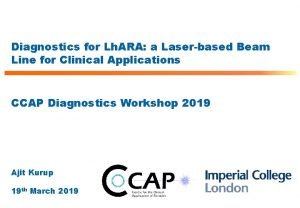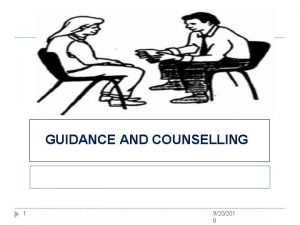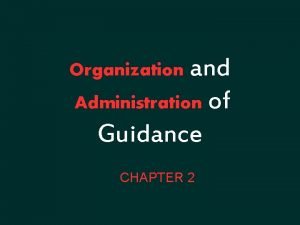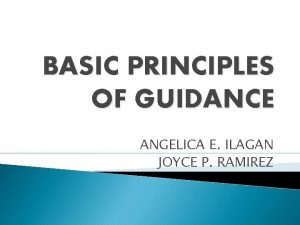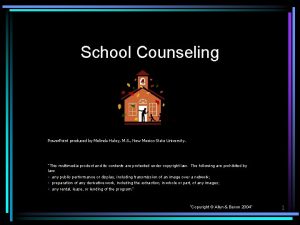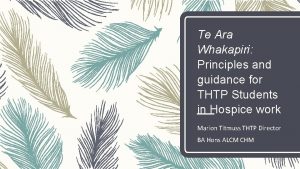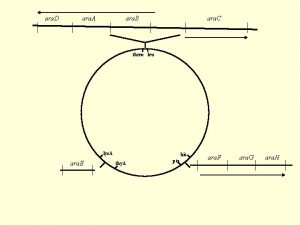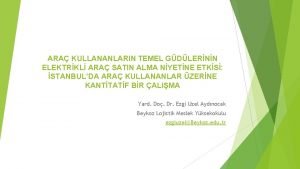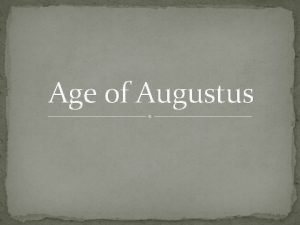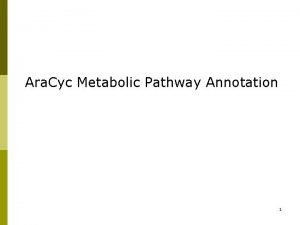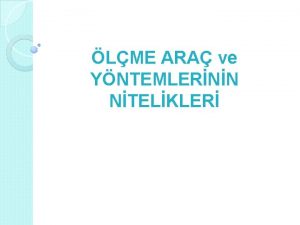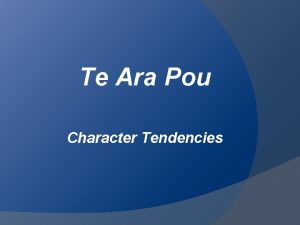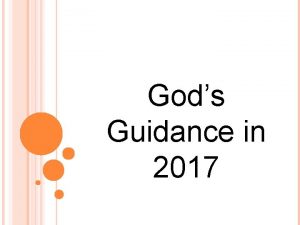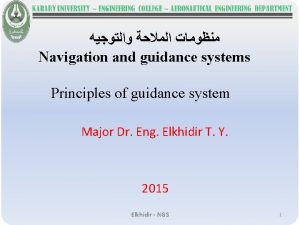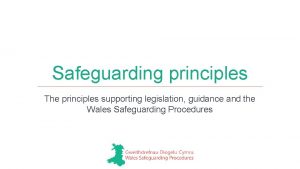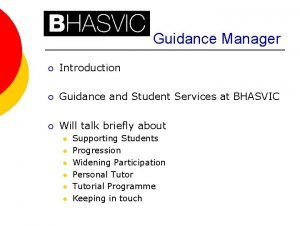Te Ara Whakapiri Principles and guidance for the
































- Slides: 32

Te Ara Whakapiri: Principles and guidance for the last days of life (insert presenter name)

Session format – The Liverpool Care Pathway for the Dying person – Background to Te Ara Whakapiri – The Toolkit (April 2017) – Quick tour of some of the contents – Implementation – Recognising dying and getting started 2

The Liverpool Care Pathway – LCP was an integrated pathway developed in the UK, aimed to transfer best practice approaches used in hospices to other settings in relation to the care of people who are dying – The LCP was introduced in New Zealand in 2006 and implemented across > 350 health care services (NZ version) – (insert local experience/history re LCP) 3

The demise of the LCP – In June 2013, an independent review lead by Baroness Julia Neuberger, identified problems with the implementation of the LCP in the UK and recommended it be replaced by individual care plans for each patient – “Tick-box exercise” with perceptions of over-sedation and lack of collaboration – Health Care Trusts were incentivised under the quality agenda – “More care, less pathway” – No evidence in NZ of poor practice around LCP but had to be withdrawn – In Dec 2013 the Ministry of Health commissioned the Palliative Care Council to initiate a programme of work to develop a “consensus on a national approach for the care of patients in their last days of life in NZ” 4

Is there a problem? – Extensive literature to show that end of life care is often managed badly – Linked with a lack of training and a lack of organisational priority – Problems arise specially if the person is not identified explicitly as dying and particularly around family and spiritual care – (insert any local experience/evidence/anecdotes) – Poor care impacts negatively on patients, families and staff – You only die once, so we have one chance to get it right 5

Place of Death 2000 -2010 For deaths > 85 yrs, 54. 8% in ARC, only 9. 9% in private residence Source: Analysis of Ministry of Health MORT data 2000 to 2010 6

Last days of life working group – Established April 2014 – Independent Review in UK analysed to assess relevance to NZ models of care, including the Liverpool Care Pathway – Stocktake of services – Literature review of evidence and best practice – Survey of family / whānau to understand the consumer perspective on the care of people in their last days of life 7

Survey findings Barriers to communication (hospital); “I did not know what ‘palliative care’ meant at the time. A doctor told me “we are offering palliative care now”. I thought it was a different type of medicine they were offering to make my Uncle well again, so it was a huge shock when he died. ” 8

Place of death “It was important for our mum to be surrounded by her whānau and mokopuna. But at the same time she didn't want to be a burden. She had been in and out of hospital but grieved for the sounds of her mokopuna playing in the background which for her gave her a sense of belonging and normality even though she was very unwell. Further, the whānau needed time to prepare for a pending death. this time with our mum sort of enabled that. She was also able to have access to constant karakia, waiata, and laughter is very healing for the spirit. ” (home) 9

Experience after death “When I saw him after he died I was amazed by the peacefulness and how the rest home staff had cared for him. This was a huge help to me. I felt that he was my dad again. I did not expect this to be the case and this will be my lasting impression. I am very grateful for this. ” (aged residential care) 10

Issues identified across all settings Instances of a lack of caring, compassion and respect in the hours/days before Poor communication with the person, family/whanau especially in aged residential care and primary care settings death e. g. poor pain control Delays in the release of the deceased from hospital Lack of access to bereavement support and information Delays in access to care and support after hours Not recognising the dying patient Lack of information for carers of what happens after death, especially post mortems and coronial processes Support after death Some families/whanau not well supported especially after sudden/unexpected deaths Family/whanau not always prepared for the final moments 11

Te Ara Whakapiri - the path to closeness/unity (the unifying path) Published December 2015

Te Ara Whakapiri focuses care on what matters most – Provision of person-centred and dignified care – Clear and compassionate communication – Attention to cultural and spiritual needs – Attention to detail on symptom management – Supporting the family/whānau – Care after death 13

Te Whare Tapa Whā model of care supports the principles of care (Durie 1985) 14

3 components to care 1. A comprehensive baseline assessment involves identifying the lead practitioner, assessing clinical needs, sensitive and open communication, and clear documentation. 2. Ongoing assessment emphasises the importance of developing individualised care plans. 3. After death care includes verification of death and the need of the family/whānau for information and privacy. 15

Each of these is addressed from the perspectives of; – the person who is dying and their family/whānau – the health professional(s) providing care – the specific clinical service or health care organisation (primary palliative care provider and/or specialist palliative care service) – the wider health system 16

Development of The Toolkit – Working group re-convened with extended membership and 4 subgroups – Initial (baseline) assessment – Symptom management guidelines and flowcharts – “Observation” chart – Care after death documentation – Concise, readable and true to the NZ environment – Applicable across all health care settings – Appropriate for the non-specialist workforce to initiate and use 17

The toolkit Fixed (apart from local logo) – Care in the last days of life Baseline assessment and care after death (4 pages) – Ongoing care of dying person page “observation chart” – Home care in the last days of life 2 page “observation chart” – Recognising the dying person flowchart – Medical management planning general principles 2 Localisable – Staff signature sheet – Bereavement risk assessment tool – Discharge checklist – Symptom management guidelines (incorporating symptom flowcharts) – When death approaches (family/whānau pamphlet) – Dying at home (family/whānau pamphlet) 18

About getting everyone on the same page…. . often the biggest challenge 19

Baseline assessment & section on care after death Completed together by nursing & medical staff Covers physical health PLUS psychological, spiritual & family health 20

21

Replaces the assessment/obs chart (double-sided) Physical, psychological, spiritual & family health 4 hrly review of symptoms, others reviewed once/shift ACE codes show priority A = Green (achieved/absent) C = Orange (a change has been required but issue is under control) E = Red (escalate – needs medical review or a change in plan) 22

5 symptom flowcharts 1 a. Pain 1 b. Pain with severe renal impairment 2. Agitation / delirium/ restlessness 3. Nausea/vomiting 4. Excess respiratory tract secretions 5. Dyspnoea 23

April 2017 http: //www. health. govt. nz/publication/te-arawhakapiri-principles-and-guidance-last-days-life 24

Power of language – Don’t shy away from “Te Ara Whakapiri” What does the phrase mean to you and how will you explain its purpose and its value? – To staff – To patients – To whānau More holistic and respectful than an acronym – Think of it as a “checklist” rather than “tick-box” 25

Implementation – (insert local plan for implementation) 26

How to get started – Be alert to the possibility your patient may be dying – Listen to junior staff/nurses/allied health, patient AND family – Make a positive decision; be clear and supportive – Complete Care in the last days of life together (nurse + doctor +/others) – Initiate the Ongoing care of the dying person chart – Utilise Symptom management guidelines if needed 27

Potential triggers – (insert any local processes e. g. daily “Board Round” or MDT) – Ceasing routine observations – Move to a single room – “Comfort cares” – Patient or family request for withdrawal of active treatment “Listen to the patient, and if the patient is unable to communicate then listen to the family/carers of the patient” (survey) 28

“Diagnosing dying” – What are the benefits? – – – – Cease burdensome/futile treatments, tests and recordings Anticipatory prescribing Inform family/whānau so they can be present Privacy (single room) – a necessity for preservation of dignity Support for family Time to say goodbye May identify that the person wishes die at home (can utilise the Discharge checklist and the Dying at home pamphlet) 29

Next steps – The BIGGEST challenge is implementation, without new resources – Hospice NZ are partnering with the MOH and other leaders to promote integration and socialisation across the health sector but locally is where the real work happens – Dying happens everywhere and quality care cannot be reliant on specialists being there all the time – Need to find creative opportunities within existing systems – This is about everyone having a role 30

“Dignity and privacy are commodities beyond value in the dying. ” unknown 31

This presentation has been developed by: Dr Kate Grundy, Palliative Medicine Physician and Clinical Director, Canterbury Integrated Palliative Care Services Helen Sawyer, Palliative Care Clinical Nurse Specialist, Southern District Health Board (Please acknowledge if you have made any changes) 32
 Te ara whakapiri toolkit
Te ara whakapiri toolkit Ara ara beam
Ara ara beam Hanau quint
Hanau quint Example of indirect guidance
Example of indirect guidance Merits of non directive counselling
Merits of non directive counselling Organization and administration of guidance
Organization and administration of guidance Angelica ilagan
Angelica ilagan The poseidon principles
The poseidon principles Melinda haley
Melinda haley Principles of guidance
Principles of guidance Principles of guidance
Principles of guidance Principles of guidance
Principles of guidance Fspos
Fspos Typiska novell drag
Typiska novell drag Nationell inriktning för artificiell intelligens
Nationell inriktning för artificiell intelligens Vad står k.r.å.k.a.n för
Vad står k.r.å.k.a.n för Varför kallas perioden 1918-1939 för mellankrigstiden
Varför kallas perioden 1918-1939 för mellankrigstiden En lathund för arbete med kontinuitetshantering
En lathund för arbete med kontinuitetshantering Underlag för särskild löneskatt på pensionskostnader
Underlag för särskild löneskatt på pensionskostnader Personlig tidbok
Personlig tidbok A gastrica
A gastrica Förklara densitet för barn
Förklara densitet för barn Datorkunskap för nybörjare
Datorkunskap för nybörjare Stig kerman
Stig kerman Att skriva debattartikel
Att skriva debattartikel Delegerande ledarskap
Delegerande ledarskap Nyckelkompetenser för livslångt lärande
Nyckelkompetenser för livslångt lärande Påbyggnader för flakfordon
Påbyggnader för flakfordon Tryck formel
Tryck formel Svenskt ramverk för digital samverkan
Svenskt ramverk för digital samverkan Lyckans minut erik lindorm analys
Lyckans minut erik lindorm analys Presentera för publik crossboss
Presentera för publik crossboss Argument för teckenspråk som minoritetsspråk
Argument för teckenspråk som minoritetsspråk

